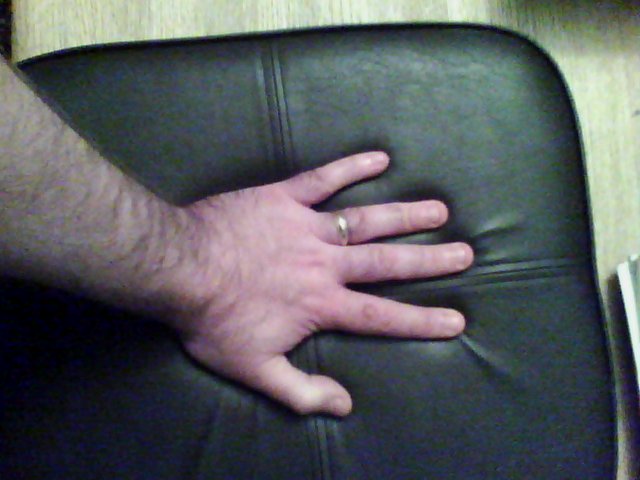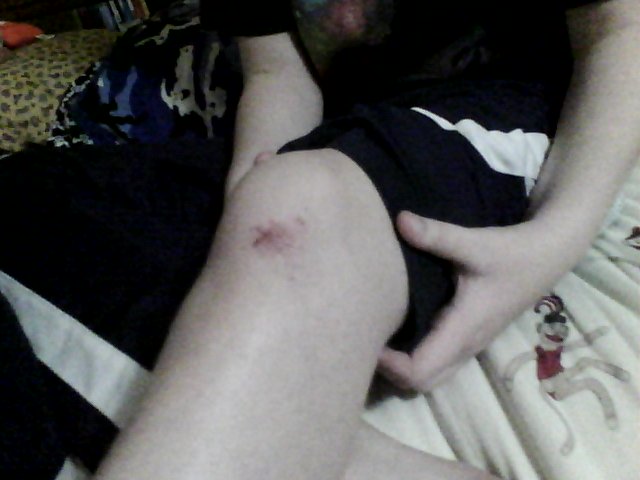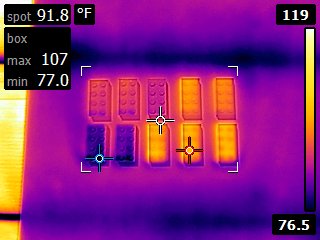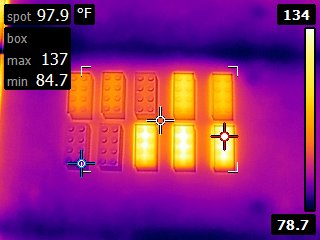On the previous page, a Flir E4 imaging device was used to find animals in the comfort of my own home. Before we get to serious work, here are a few more odd thermal photos.
The obligatory handprint thermal image is a common image in thermal galleries. Here, I press down on a plastic chair pad with my hand. Notice the darkness of the gold wedding ring, despite it likely being the same temperature as the rest of my hand.


Hand print making (infrared and visible)
When I lift my hand, a thermal and physical impression remains in the cushion.


Hand print on cushion (infrared and visible)
Before taking a photo, I have a professional habit of rearranging the subjects. Yet, with a thermal camera, even the briefest touch leaves a heat signature for several minutes. I then need to go away for a while before taking the shot. Here is a handprint on a solid wood table.


Hand print on wooden table (infrared and visible)
You can imagine how obvious the thermal impression is from a person sitting in a chair, or using a mouse and keyboard. Even petting a cat changes the thermal appearance of its fur.
This brings up a potential security concern. With the Flir E4 thermal camera, finger presses on a security keypad or computer keyboard remain visible for a short time.


Thermal camera reveals security code (infrared and visible-light)
Before you panic, realize that this does not reveal digit order, and visible wear on keypads has been revealing this type of information for decades. However, thermal imaging might be helpful on door locks, ATM pin keypads, or debit-card pin pads where the code differs between users. Metal keys mitigate this issue, as most thermal cameras perform poorly with such materials.
My son, Sam, took a tough spill on his bike. Even several days later, the extra blood flowing to the injury site is obvious.


Extra blood flow to injured knee (infrared and visible)
His elbow isn’t quite as bad. But, you can still see the repairs in progress.


Extra blood flow to scraped elbow (infrared and visible)
Years ago, at the Museum of Science and Industry, there was a high-end thermal camera for the visitors. I remember how instantly obvious it was that Sam had a cold that day.
I wonder what other diagnoses could be aided by the greater availability of such cameras. Next time the doctor says “Sorry, I don’t see anything”, just whip out your infrared camera to display the difference in temperature around a pain point.
Sam gathered a variety of colors and shades of 2x4 Lego bricks. Placing the Legos in the sun and taking thermal images at regular intervals reveals the difference in solar energy absorption rate of a like-material depending on its color.
A temperature difference is immediately apparent just seconds after placing them on the surface. We hadn’t even had time to straighten them yet.


Multicolor Lego bricks (visible and infrared)
At one minute, a 30-degree Fahrenheit difference had already developed.

Multicolor Lego bricks (infrared) after 1 minute
At three minutes in the sun, the black Lego brick reached 120° F. The surface was a relatively mild 78.6° F.

Multicolor Lego bricks (infrared) after 3 minutes
By five minutes, the black Lego brick climbed another 10 degrees Fahrenheit, just from sunlight.

Multicolor Lego bricks (infrared) after 5 minutes
At nine minutes, the difference between the white Lego brick (84.7° F) and the black Lego brick (137° F) was 53 degrees Fahrenheit.

Multicolor Lego bricks (infrared) after 9 minutes
This turned out to be a rather fun experiment. However, it is now time to turn to more serious matters -- home energy usage.